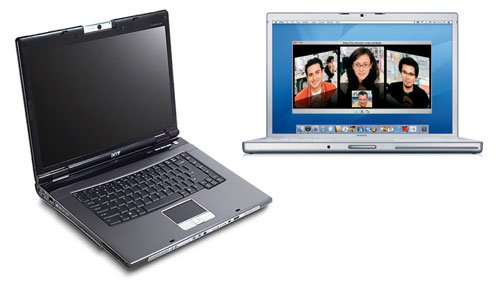Hosted by site sponsor WebMate.
MacBook Pro Q&A - Revised November 19, 2006
To be notified of new Q&As, sign up for EveryMac.com's bimonthly email list.
How does the MacBook Pro "Core Duo" 15-Inch compare to a similar Windows notebook?
Please note that all systems mentioned in this Q&A have been discontinued. The MacBook Pro "Core Duo" models were replaced by the "Late 2006" MacBook Pro "Core 2 Duo" series.
One of the advantages from the consumer's standpoint is that the switch to Intel-based processors makes it easier than ever to compare Apple's systems directly to Windows PCs.
One such system that is similar enough for a direct comparison to the MacBook Pro "Core Duo" 2.0 15-Inch is the Acer TravelMate 8200. Both notebooks were announced in January 2006, but changes have occurred since that time. On May 16, 2006, Apple "boosted" the speed of the MacBook Pro "Core Duo" 1.83 15-Inch to equal this model (which effectively was the same as reducing the RAM, hard drive size, and video card of the MacBook Pro "Core Duo" 2.0 15-Inch and slashing the price). The Acer TravelMate 8200, on the other hand, had its list price reduced after introduction but still was configured the same.

Photo Credit: Acer (Left) & Apple Computer (Right)
Both systems feature 2.0 GHz Intel Core Duo processors with a 2 MB shared "on chip" level 2 cache, similar logic board designs with a 667 MHz frontside bus and 667 MHz PC2-5300 DDR2 SDRAM.
The MacBook Pro and the TravelMate 8200 have 5400 RPM Serial ATA hard drives with anti-shock technology designed to stop the hard drive heads from moving if the laptop is dropped or jolted suddenly (the "Sudden Motion Sensor" for the MacBook Pro and "Disk Anti-Shock Protection+" for the TravelMate 8200), as well as DVD burners.
Both systems are equipped with ATI Mobility Radeon X1600 graphics processors, although the MacBook Pro "Core Duo" models support dual-link DVI and Acer's website does not seem to mention dual-link DVI capabilities (simply that it has DVI out).
Both the Acer and the Apple also have 802.11a/b/g support (dubbed AirPort Extreme on the MacBook Pro), Bluetooth 2.0+EDR, Gigabit Ethernet, a FireWire "400" port, optical digital audio in/out, an ExpressCard/34 expansion slot, and an integrated video camera. However, there are other ports that are provided by one notebook or the other (summarized below).
The MacBook Pro "Core Duo" 15-Inch has a 15.4" widescreen TFT active-matrix display (1440x900 native) that Apple states is 67% brighter than the display provided by its predecessor, and the TravelMate 8200 has a display of the same size that is higher-resolution than the MacBook Pro (1680x1050 native).
There are notable configuration differences as well. For your convenience, these differences are summarized in this handy table:
| TravelMate 8200 | MacBook Pro 2.0 15" | |
|---|---|---|
| Original (Current) Memory: | 2.0 GB | 1.0 GB (512 MB) |
| Original (Current) Hard Drive: | 120 GB | 100 GB (80 GB) |
| Original (Current) Graphics: | 256 MB | 256 MB (128 MB) |
| DVD±RW Capabilities: | Dual Layer DVD | Single Layer DVD |
| Native Resolution: | 1680x1050 | 1440x900 |
| Different Ports: | 4 USB 1.1 S-Video Out Docking Station Type II PC Card Slot 5-in-1 Card Reader 56k v.92 Modem |
2 USB 2.0 |
| Weight: | 6.6 lbs. | 5.6 lbs. |
| Original (Current) List Price: | US$2499 (US$2099) | US$2499 (US$1999) |
The Acer system lacks the fiber-optic-based "ambient light sensor" that automatically "measures ambient light and works with integrated software to adjust keyboard illumination and screen brightness based on user preferences", the "scrolling TrackPad" that allows one to scroll or pan by touching the trackpad with two fingers instead of one, the Apple Remote for use with Apple Front Row media organization software, and the new clever magnetically connected "MagSafe" power connector that safely disconnects if someone accidentally trips over the cord.
As one would expect for a Windows notebook, the Acer system also is larger, arguably less attractive, and a full pound heavier than the MacBook Pro.
From evaluating the above table, on a straight "specs to specs" basis (disregarding design, elegance, and weight) it is clear that the MacBook Pro "Core Duo" on July 28, 2006, when this answer was last updated, was not as price competitive as it was at the time of its release. Apple likely will need to become more aggressive about price cutting to compete in the Intel-based systems market. Prices tend to be in effective free fall at all times.
Of course, Apple does not support running MacOS X on the Acer system, and regardless of the underlying hardware and feature set, that remains perhaps the most important distinction.
Permalink | Report an Error/Typo | Sign Up for Site Update Notices
Established in 1996, EveryMac.com has been created by experts with decades of experience with Apple hardware. EveryMac.com includes, and always has included, original research incorporating detailed, hands-on inspection of packaging, computers, and devices as well as extensive real-world use. All information is provided in good faith, but no website or person is perfect. Accordingly, EveryMac.com is provided "as is" without warranty of any kind whatsoever. EveryMac.com, and the authors thereof, shall not be held responsible or liable, under any circumstances, for any damages resulting from the use or inability to use the information within. For complete disclaimer and copyright information please read and understand the Terms of Use and the Privacy Policy before using EveryMac.com. Copying, scraping, or use of any content without expressed permission is not allowed, although links to any page are welcomed and appreciated.
